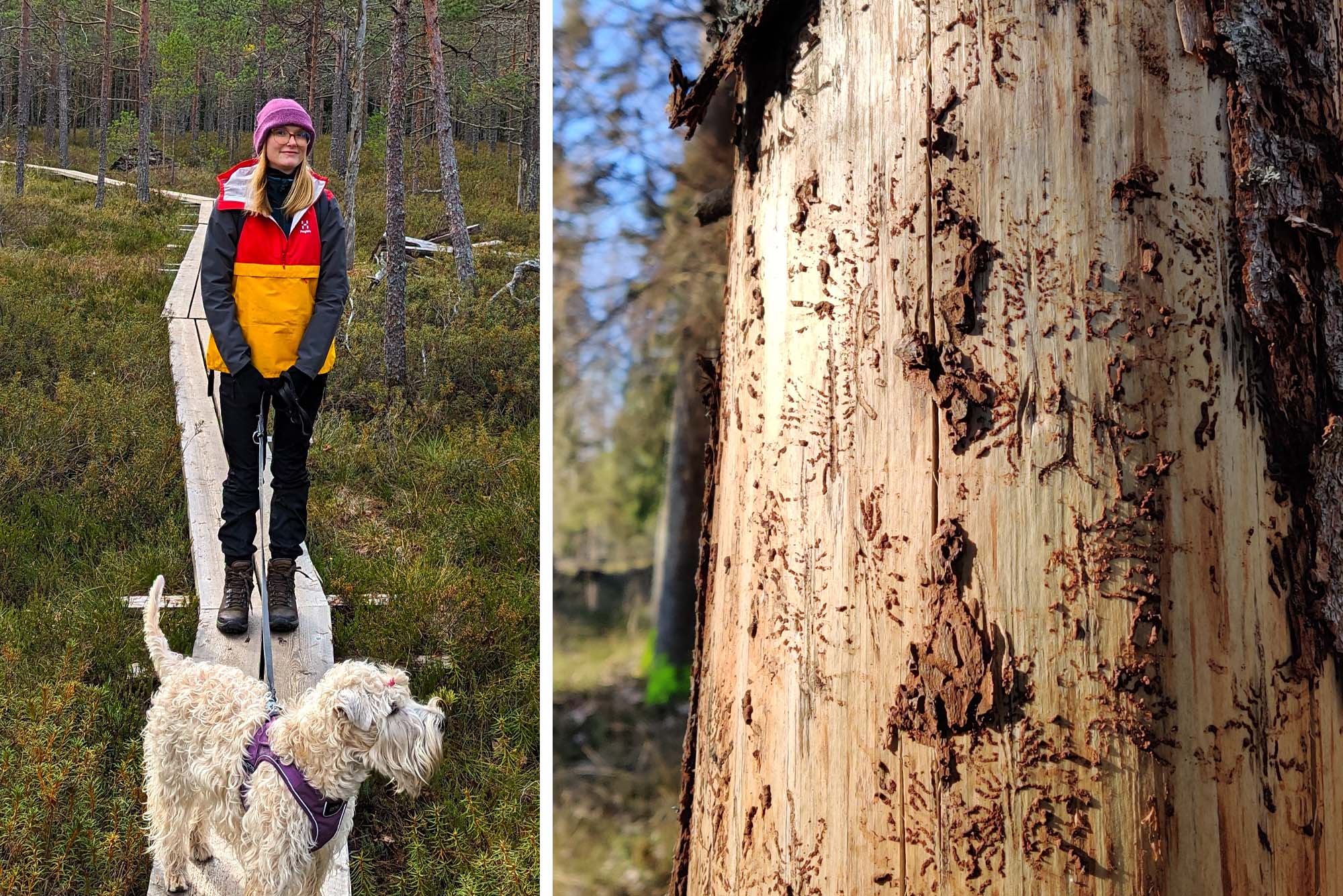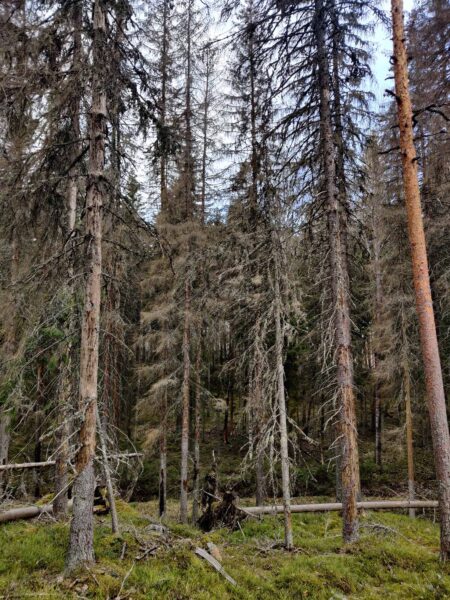
Werna Wahlman lists signs that reveal the risk of damage by the European spruce bark beetle.
’The Heterobasidion parviporum fungus appears to be one of the important factors exposing Norway spruce to damage by the European spruce bark beetle. That’s especially before the beetles get plentiful,’ says Werna Wahlman from the University of Helsinki.
Wahlman observed that three out of four spruces infected by Heterobasidion were also suffering from the spruce bark beetle.
’So if you treat tree stumps to protect standing trees from Heterobasidion, you can indirectly help to avoid damage by the spruce bark beetle, Wahlman says.
The facts related to damage by the European spruce bark beetle are described in Wahlman’s master’s thesis effect of Heterobasidion root rot on Ips typographus infestation risk on Norway spruce, submitted in March at the University of Helsinki.

According to Wahlman, an indirect connection between Heterobasidion and the spruce bark beetle has been known. Her master’s thesis was the first field study to examine a direct connection between the two. Previously, there have only been ’educated guesses’ about the matter.
’The fungus weakens the tree roots, making it more vulnerable to wind damage, and windfall trees attract the spruce bark beetle,’ Wahlman explains.
Heterobasidion species are extremely harmful fungi that decay conifers, causing considerable financial losses in Finland and elsewhere in Europe every year. They weaken forest growth and its ability to bind carbon dioxide. Insect damage is another threat to tree health. Over 6,000 hectares of forest was felled in Finland in 2022 because of it. The extent of fellings due to insect damage has been on the rise.
In recent years, the spruce bark beetle has destroyed huge areas of forest in Germany and the Czech Republic.
Insects attack stressed trees
Heterobasidion makes trees more vulnerable to insects.
’With the progress of decay, the tree is less able to absorb water, which reduces the hydrostatic pressure. Decay may disturb the flow of water from the roots upwards,’ Wahlman says.
Hydrostatic, or turgor, pressure refers to the pressure created by water inside plant cells. The pressure maintains cell structure and promotes the flow of water and nutrients in plants.
Heterobasidion also inhibits the secretion of resin.
’Trees suffering from stress cannot protect themselves against the spruce bark beetle by secreting resin,’ Wahlman says.
Read more: Natural enemies may prevent damage by spruce bark beetle – researcher explains how
Live Norway spruces and those suffering from only a mild bark beetle infestation exhibited less Heterobasidion infection than those killed or severely infested by the bark beetle.

’The observation indicates that Heterobasidion is more important especially at the onset of a spruce bark beetle infestation than it is later. Once the beetle population reaches sufficient numbers, they can also attack trees that appear healthy,’ Wahlman says.
The study examined 442 Norway spruces infested by the European spruce bark beetle on nine different regeneration felling sites. The study also found a great number of trees infested by the spruce bark beetle but with no Heterobasidion.
’This means that there must also be other explaining factors besides Heterobasidion behind a spruce bark beetle infestation,’ Wahlman ponders.
Wahlman says that in addition to Heterobasidion, her study found two other, though weaker, predictors of damage: a smaller increase of tree diameter over the past five years, and a greater diameter of tree trunk at chest height.
’The study found a positive correlation between tree diameter and presence of the spruce bark beetle. The greater the diameter, the more probably the tree will be attacked by the beetle. This has also been noted in several other studies,’ Wahlman says.
Other damage predictors were the higher basal area of spruces, greater tree density in the stand, stress caused by drought and increased light due to fellings.
Basal area refers to the sum per hectare of the cross sections of trees measured at chest height.
Mixed forests are less vulnerable
According to Wahlman, Heterobasidion can be fought by scheduling fellings for winter, and by treating stumps during the warmer season when the fungus produces spores.
Immediately after cutting a tree, the forest machine [LINKKI]treats the stump with either urea or with spores of the Phlebiopsis gigantea fungus, a competitor of Heterobasidion.
Wahlman also points out that simply fighting Heterobasidion is not enough to protect the forest against the spruce bark beetle; other forest management operations are also needed.
’In general, mixed forests are less vulnerable to extensive damage by the spruce bark beetle,’ Wahlman notes.
On the other hand, thinning can expose the remaining trees to Heterobasidion. If the thinning is too intensive, it will reduce shade in the forest. The sudden increase of light may cause stress. Compromises are always needed in forest management.
Adequate thinning can improve access to water and reduce competition in a stand. However, even this is not that straightforward.
’On the other hand, thinning can expose the remaining trees to Heterobasidion. If the thinning is too intensive, it will reduce shade in the forest. The sudden increase of light may cause stress. Compromises are always needed in forest management,’ Wahlman says.
Heterobasidion
Species of the Heterobasidion fungi are an important cause of decay in conifers and can lead to tree death.
They weaken tree growth and the quality of timber.
Two species are found in Finland: Heterobasidion parviporum, causing root and butt rot in Norway spruce, and Heterobasidion annosum sensu stricto, causing butt rot in Scots pine.
A third species, Heterobasidion abietinum, is found in Central and Southern Europe.
The fungi are most commonly found in commercial forests, especially after fellings undertaken during the warm season.
The spores of these fungi are spread through air and infect trees through untreated stumps and damaged trunks. The mycelium spreads to neighbouring trees via root connections.
The spores may remain viable in the stumps for decades. In badly infected areas, the only remedy may be re-planting with another tree species.
European spruce bark beetle
A dark brown bark beetle about 5 millimetres long, lives on spruce.
Mostly breeds on windfall trees, in piles of spruce logs and on weak live trees.
If populous, may also attack live trees.
Sources Werna Wahlman, Natural Resources Institute Finland
